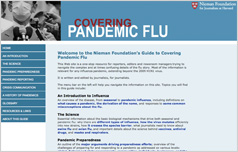 Cambridge, Mass. – The Nieman Foundation for Journalism at Harvard today is launching a comprehensive online guide to covering pandemic flu. Written by and for journalists, www.coveringflu.org is a one-stop resource designed to help reporters, editors, producers and other media professionals understand the complexities of the flu story. It also offers guidance and best practices for reporting on the topic.
Cambridge, Mass. – The Nieman Foundation for Journalism at Harvard today is launching a comprehensive online guide to covering pandemic flu. Written by and for journalists, www.coveringflu.org is a one-stop resource designed to help reporters, editors, producers and other media professionals understand the complexities of the flu story. It also offers guidance and best practices for reporting on the topic.
Journalists using the Nieman guide can quickly access essential elements of the flu story and learn from veteran reporters and editors who have covered outbreaks such as SARS, avian influenza, and the first wave of H1N1 in spring 2009. They also can discover how to maintain their independence and continue to exercise rigorous journalistic inquiry when called on by the government and/or public health officials to share messages with the public in times of crisis.
As misconceptions about the flu, the H1N1 vaccine, government preparedness and other issues continue to swirl and confuse the public, careful, well-researched reporting on the topic is more important than ever. And with both seasonal and H1N1 flu vaccination campaigns and other response measures coming into full swing this fall and winter, coverage that neither sensationalizes nor sugarcoats the news is crucial.
In explaining the importance of the guide, the Nieman Foundation’s special projects manager and site editor Stefanie Friedhoff said, “We believe that understanding the subject matter well and knowing where to turn for accurate information is the best way for journalists to avoid the pitfalls of both pandemic hype and pandemic fatigue. Our guide will help these journalists—whether seasoned health correspondents or general assignment reporters—provide nuanced reporting on topics that are too often painted in black and white. In the process, they will perform a vital public service.”
Nieman Foundation Curator Bob Giles added, “Journalists covering H1N1 need to provide context and clarity on a subject rife with uncertainty, change and confusion. Our guide is meant to assist them in their task.” Over time, the Nieman guide will be updated and expanded as an online aid for journalists reporting on other health crises.
Topics on www.coveringflu.org include:
An Introduction to Influenza
An overview of the disease, from seasonal to pandemic influenza, including definitions on what causes a pandemic, the derivation of the name, and responses to some common misconceptions about the flu.
The Science
Essential information about the basic biological mechanisms that drive both seasonal and pandemic flu: why there are different types of influenza, how the virus mutates efficiently into new strains, how it crosses the species barrier, what journalists need to know about swine flu and avian flu, and important details about the science behind vaccines, antiviral drugs, and masks and respirators.
Pandemic Preparedness
An outline of the major arguments driving preparedness efforts; overview of the challenges of preparing for and responding to a pandemic as addressed on various levels: global, federal and state governments, communities, individuals, businesses, and the sciences; plus some basics on understanding medical and non-medical interventions.
Pandemic Reporting
Stories of struggles, observations, insights, tips and story ideas from veteran flu reporters including Helen Branswell, The Canadian Press; Maryn McKenna, independent journalist; Maggie Fox, Reuters; Margie Mason, The Associated Press, and Alan Sipress, The Washington Post.
Crisis Communication
A rare view into the inner world of public health message-making, including frank accounts by communication specialists from WHO and the CDC; tips from an epidemiologist on how journalists can deal with all the uncertainties in this story; insights into how people may react in a severe pandemic and how officials plan to manage panic; and some observations by a leading risk consultant on how emotions shape what we think and do about risks and on what journalists—and officials—are getting wrong about this pandemic.
A History of Pandemics
A quick overview of past pandemics that shape current discussions—the Spanish Flu in 1918-19 and the swine flu scare in 1976—as well as other pandemics.
Glossary
A list of the major terms used by officials and scientists, and their definitions.
Resources & Links
A list that will help journalists sort through some of the major Web sites and online resources that provide information on various aspects of the flu story.
Established in 1938, the Nieman Foundation for Journalism at Harvard administers the oldest midcareer fellowship program for journalists in the world. The fellowships are awarded to working journalists of accomplishment and promise who travel to Harvard University for a year of study, seminars and special events. More than 1,300 journalists from 89 countries have received Nieman Fellowships.
The Nieman Foundation also publishes the quarterly magazine Nieman Reports, the nation’s oldest magazine devoted to a critical examination of the practice of journalism, and is home to the Nieman Journalism Lab, which identifies emerging business models and best practices in journalism in the digital media age. Additionally, the foundation runs the Nieman Narrative Digest, a compendium of the very best narrative journalism, and the Nieman Watchdog Project, which encourages reporters and editors to monitor and hold accountable those who exert power in all aspects of public life.
